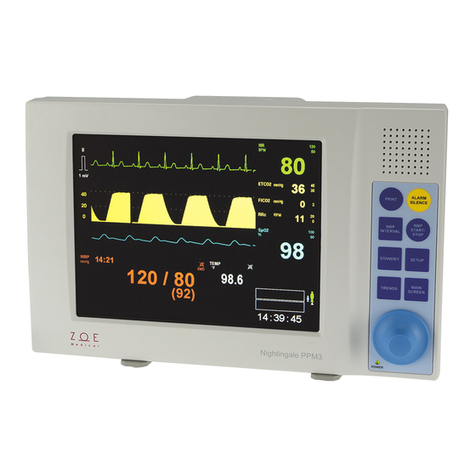ZOE 740 SELECT User manual

21-22-0335 Rev D Page 1 of 40
740 SELECT™
Multi-Parameter Monitor
User Manual Addendum - ECG & Resp Parameters
This User Manual Addendum describes the features and operations of
the 740 SELECT Multi-Parameter monitor: Software Version 2.3 or above.

Overview 740 SELECT
21-22-0335 Rev D Page 2 of 40
1. Overview
TRADEMARKS
Trademarked names appear throughout this document. Instead of inserting a trademark symbol
with each mention of the trademarked name, the publisher states that it is using the names only
for editorial purposes and to the benefit of the trademark owner with no intention of improperly
using that trademark.
is a registered trademark of Zoe Medical, Inc.
740 SELECT ™
is a trademark of Zoe Medical, Inc.
Refer to the 740 SELECT User Manual, Zoe Medical PN 21-22-0316, for a list of trademarks.

Overview 740 SELECT
21-22-0335 Rev D Page 4 of 40
CONVENTIONS USED IN THIS MANUAL
Warning: Directions that warn of conditions that put the patient or the caregiver at risk.
Caution: Directions that help to avoid damaging the 740 SELECT monitor or losing data.
Note: Directions that make it easier to use the 740 SELECT monitor.
IMPORTANT:
Read the 740 SELECT User Manual, Zoe Medical PN 21-22-0316 carefully
before patient use of the Monitor.
This Manual addresses all optional ECG parameters of the 740 SELECT
monitor.
Read this Manual carefully before patient use of the Monitor.
Zoe Medical reserves the right to make changes to this Manual and improvements to
the product it describes at any time without notice or obligation.
Copyright ©2021 Zoe Medical. All rights reserved
REVISION HISTORY
This Manual has a revision number located at the bottom of each page. It changes whenever
the Manual is updated.
Rev A
October 2015
Rev B
March 2019
Rev C
April 2020
Rev D
October 2021
WARRANTY
Refer to the 740 SELECT User Manual, Zoe Medical PN 21-22-0316, for full Warranty Policy for
Zoe Medical 740 SELECT monitor. In all cases, policy applies from date of purchase from Zoe
Medical or its authorized distributors or agents.
ECG Accessories: Out-of-box failure only

Overview 740 SELECT
21-22-0335 Rev D Page 5 of 40
TABLE OF CONTENTS
1. Overview..............................................................................................................2
TRADEMARKS............................................................................................................2
CONTACT ADDRESSES.............................................................................................3
CONVENTIONS USED IN THIS MANUAL...................................................................4
REVISION HISTORY...................................................................................................4
WARRANTY ................................................................................................................4
2. INTENDED USE...................................................................................................8
INTENDED USE..........................................................................................................8
OVERVIEW OF HEART RATE MONITORING ............................................................8
OVERVIEW OF RESPIRATION RATE MONITORING ................................................9
PEDIATRIC CONSIDERATIONS.................................................................................9
3. ECG MONITORING............................................................................................10
WARNINGS...............................................................................................................10
CAUTIONS ................................................................................................................11
NOTES ......................................................................................................................11
GETTING STARTED WITH ECG...............................................................................12
CHECKING THE ECG SIGNAL .................................................................................15
ELECTRODE PLACEMENT ......................................................................................16
STANDARD PLACEMENT (AHA)..........................................................................16
STANDARD PLACEMENT (IEC) ...........................................................................16
PLACEMENT FOR PACED PATIENTS (AHA).......................................................17
PLACEMENT FOR PACED PATIENTS (IEC)........................................................17
VERIFYING PROPER PACEMAKER HANDLING .....................................................18
FREEZING WAVEFORMS.........................................................................................18
ECG SETUP..............................................................................................................19
ECG LEAD WAVEFORM.......................................................................................19
ECG SIZE..............................................................................................................19
SWEEP SPEED.....................................................................................................19
ECG CASCADE.....................................................................................................20
HR PARAMETER SETUP..........................................................................................21
HR ALARM LIMITS:...............................................................................................21
HR AUTO (set) ALARM LIMITS.............................................................................21
HR SOURCE .........................................................................................................22
ANALYZE PACERS...............................................................................................23
PULSE TONE........................................................................................................23
ECG LEAD.............................................................................................................23
SIZE.......................................................................................................................23
ECG FILTER..........................................................................................................24
CAL PULSE...........................................................................................................24
TESTING HR ALARMS..............................................................................................24
ECG AND HEART RATE MONITORING MESSAGES ..............................................25
4. RESPIRATION MONITORING...........................................................................26
WARNINGS...............................................................................................................26
NOTES ......................................................................................................................26
ENABLING DISPLAY OF RESPIRATION..................................................................27
GETTING STARTED WITH RESPIRATION...............................................................27
CHECKING THE RESPIRATION SIGNAL.................................................................27
FREEZING WAVEFORMS.........................................................................................28
Table of contents
Other ZOE Medical Equipment manuals
Popular Medical Equipment manuals by other brands

Getinge
Getinge Arjohuntleigh Nimbus 3 Professional Instructions for use

Mettler Electronics
Mettler Electronics Sonicator 730 Maintenance manual

Pressalit Care
Pressalit Care R1100 Mounting instruction

Denas MS
Denas MS DENAS-T operating manual

bort medical
bort medical ActiveColor quick guide

AccuVein
AccuVein AV400 user manual













